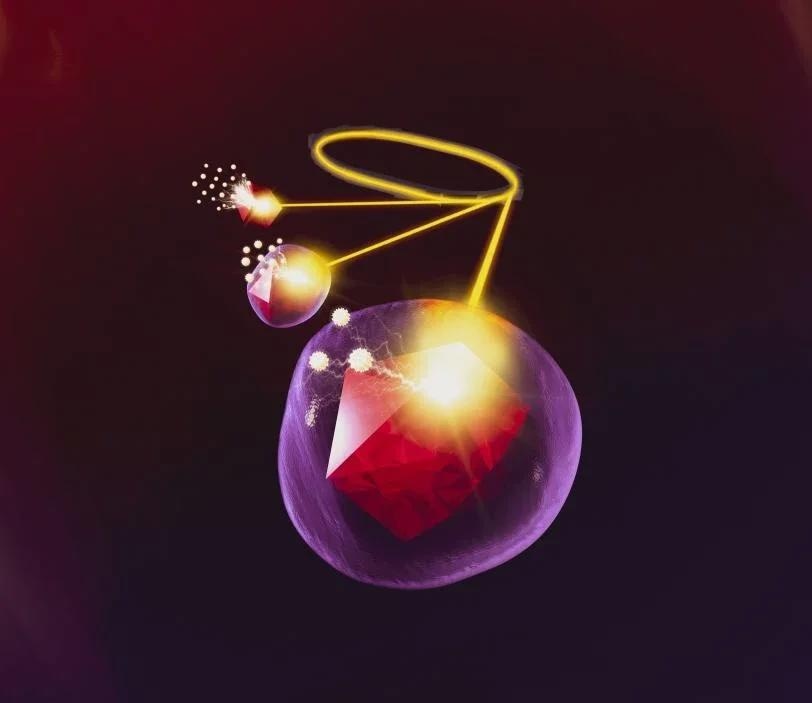X-Ray tools at SSRL reveal that alcohol groups on the surface of nanodiamonds enable one of the world's most valuable materials to bond with one of its most abundant materials.

SSRL’s X-Ray facilities and transition edge sensor reveals information about the nanodiamond hidden below a silica coating. Irradiated electrons escape from the nanodiamond’s surface, travel through the silica, and are collected as signals. The thicker the coating, the fewer electrons make it to the surface. Understanding the chemistry of silica coatings will help researchers optimize silica shells and try other materials as coatings, expanding nanodiamonds’ applications in quantum computing and biolabeling. (Image Credit Greg Stewart/SLAC National Accelerator Laboratory)
Coating something unique – small shards of a diamond – with the primary ingredient in sand might sound uncommon. However, the end result apparently has a number of useful applications. The intriguing part is that there is still uncertainty about the exact mechanism of how these two materials bond.
Scientists from San Jose State University (SJSU) report in the journal ACS Nanoscience Au that alcohol chemical groups on a diamond’s surface are responsible for silica shells, an outcome that could help them to make improved silica-coated nanodiamonds–small tools with applications from biolabeling of cancer cells to quantum sensing.
The research group showed the bonding mechanism as a result of the strong X-Rays produced by the Stanford Synchrotron Radiation Lightsource (SSRL) at the DOE’s SLAC National Accelerator Laboratory.
Now that we know these finer details – how the bond works instead of just guessing – we can better explore new diamond hybrid systems.
Abraham Wolcott, Study Principal Investigator and Professor, San Jose State University
The majority of Wolcott’s work concerns nanodiamonds, synthetic diamonds shattered into pieces so small that one requires nearly 40,000 of them to span the width of a single human hair.
Theoretically, nanodiamonds have ideal carbon lattices, but occasionally, a nitrogen atom sneaks in and substitutes a carbon atom next to a missing carbon atom.
It is technically known as a defect, but it is beneficial–the defect reacts to electric fields, magnetic fields, and light, all at room temperature, implying nanodiamonds have several applications. They could be utilized as qubits, the basic unit for a quantum computer.
Hit them with green light, and they glow red, so biologists could put them in living cells and track them as they move. However, researchers cannot easily program nanodiamonds to go where they wish, and diamond edges are pointy and could cause cell membranes to rupture.
Coating them with silica resolves both issues. Silica develops a smooth and even shell that covers the sharp edges. Also, it makes a modifiable surface, which researchers could decorate with tags to direct the particles toward particular cells, like neurons or cancer cells.
The diamond with silica shell becomes a controllable system.
Abraham Wolcott, Study Principal Investigator and Professor, San Jose State University
However, for some time, Wolcott stated, researchers have not agreed on how that shell is developed. His team showed that ammonium hydroxide with ethanol, chemicals normally involved in the coating process, produces several alcohol groups on the nanodiamond surface, and those alcohols streamline the growth of the shell.
Nobody was able to explain it for over 10 years. but we were able to tease out that information.
Abraham Wolcott, Study Principal Investigator and Professor, San Jose State University
Following an examination of the particles using transmission electron microscopes at the DOE's Lawrence Berkeley National Laboratory Molecular Foundry, the scientists directed SSRL X-rays toward nanodiamonds to investigate the concealed surfaces beneath the silica coating.
SSRL’s transition edge sensor – a super-sensitive thermometer that gathers temperature changes and transforms them to X-ray energies – showed which chemical groups were present on the surfaces of the nanodiamonds.
With the help of a second method – X-ray absorption spectroscopy (XAS) – the research group produced mobile electrons on the nanodiamond surface, further catching them as they traveled through the silica shell and escaped.
The thicker the coating, the fewer electrons went all the way to the surface. The signals served like a small measuring tape, thereby displaying the thickness of the silica coating on the nanometer scale.
Wolcott stated, “XAS is powerful because you can detect something that is submerged, that's hidden – like diamond underneath a silica shell. Folks have never done this with nanodiamonds before, so in addition to figuring out the bonding mechanism, we’ve also shown that XAS is useful for material scientists and chemists.”
In the forthcoming days, Wolcott, who is known for offering hands-on research opportunities, wishes to put students to work coating nanodiamonds with other materials. Zinc, Titanium, and other metal oxides, for instance, could set the stage for avenues in quantum sensing and biological labeling applications.
“Nanodiamonds are incredible microtools with immediate applications. Now that we understand how the silica shell forms, we can begin optimizing it and expanding to other types of materials,” stated Karen Lopez, a biomedical engineering Ph.D. student at the University of California, Irvine, who, like the other SJSU authors, worked on the study as an undergraduate.
This study was financially supported in part by the DOE’s Office of Science and the Laboratory Directed Research and Development program.
Journal Reference
Sandoval, P. J., et al. (2023) Quantum Diamonds at the Beach: Chemical Insights into Silica Growth on Nanoscale Diamond using Multimodal Characterization and Simulation. ACS Nanoscience. doi.org/10.1021/acsnanoscienceau.3c00033.